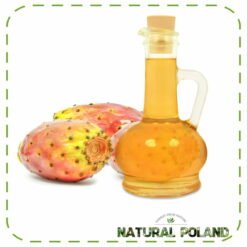Our food-grade sea buckthorn oil can be utilized in the food industry as a medicinal and flavoring product, and in the cosmetic industry for skin care.
Properties
The oil content in the fruit pulp is approximately 1.5-3% (in fresh weight).
Sea Buckthorn Fruit Oil contains monounsaturated fatty acids and carotenoids, as well as significant amounts of tocopherols, tocotrienols, and plant sterols.
Oils from common sea buckthorn seeds and fruit differ in their fatty acid profiles. Linoleic acid and α-linolenic acid are the main fatty acids in seed oil, whereas sea buckthorn fruit oil contains approximately 65% combined monounsaturated fatty acids, palmitoleic acids, and the saturated fatty acid – palmitic acid. This results in a fundamental difference between the two oils in terms of appearance and consistency.
Sea buckthorn fruit oil is clear, dark orange in color, and has a thick consistency. Carotenoids are pigments that give the sea buckthorn berry its distinctive orange-red color; these compounds are present in significant amounts in the pressed oil. The main carotenoids present in sea buckthorn fruit oil are beta-carotene, zeaxanthin, and lycopene.
The oil has a characteristic, raw taste with a hint of bitterness, without undesirable odors.
Our Sea Buckthorn Fruit Oil Has a High Concentration of Carotenoids, Min. 250 Mg.
 Sea buckthorn oil is obtained from the fruit of this plant. This product is pressed and unrefined, thus retaining many of its natural, health-promoting properties. Sea buckthorn fruit oil is rich in a large amount of unsaturated fats, including palmitoleic acid, as well as vitamin C, riboflavins, vitamins A, E, and B12. It contains microelements such as selenium, iron, copper, phosphorus, and magnesium. Organic sea buckthorn oil counteracts inflammation of the digestive system, reduces stomach ailments, and also excellently moisturizes the skin and prevents its aging.
Sea buckthorn oil is obtained from the fruit of this plant. This product is pressed and unrefined, thus retaining many of its natural, health-promoting properties. Sea buckthorn fruit oil is rich in a large amount of unsaturated fats, including palmitoleic acid, as well as vitamin C, riboflavins, vitamins A, E, and B12. It contains microelements such as selenium, iron, copper, phosphorus, and magnesium. Organic sea buckthorn oil counteracts inflammation of the digestive system, reduces stomach ailments, and also excellently moisturizes the skin and prevents its aging.
Health Benefits:
- It aids in epidermal regeneration, supports wound healing, and protects the skin from free radical damage.
- It soothes irritations, reduces redness and skin inflammation, and can also be used in the care of problematic, dry, and mature skin.
- It positively affects the immune system, helping to protect the body from oxidative stress.
Applications:
In cosmetics, sea buckthorn oil can be used directly on the skin or as an additive to cosmetic products.
In dietary supplements, it supports the proper functioning of the digestive and immune systems.
In the food industry, it can be used as a food oil, providing valuable nutrients. Due to its specific taste, it is best used in small quantities as an addition to salads and dressings.








